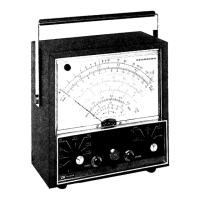TEST INSTRU MI]NT
SAI.'ETY
WARNING
Normal use of
tcst cquipmcnt cxposes
you
to a
ccrtain
amount
of
danger fiom
elcctrical
shock
becausc testing must often be
performed
where exposed voltage
is
present.
An
electrical
shock causing 10
milliamps of ourrent to
pass
through the heart will stop most human
hcartbeats. Higher voltages
pose
an even
greatcr
thrcat because such voltage
can more easily
producc
a lcthal current. However, voltage
as low as 35 volts DC
or AC RMS should
be
considered dangcrous
and
hazardous
since it can
produce
a
lcthal
current under ccrtain
conditions. Your normal
work
habits
should include
all accepted
practices
that
will
prevcnt
contaot with
cxposed high
voltage,
and that will steer
current away
from
your
heart in
casc of
accidental
contact
with a high
voltage.
You will significantly
reducc thc risk factor if
you
know
and observe the following safety
precautions:
1.
Don't
cxpose high voltage needlessly. Removc housings
and
covers
only
whcn
ncccssary.
Turn off cquipmcnt while making tcst connections in liigh-voltagc
circuits. Dischargc
high-voltagc capacitors
after
removing
power.
2. Use
an
insulated floor
material or a
large,
insulated floor mat to stand
on, and
an
insulated
work
surfacc on which to
placc
cquipment;
and make certain such surfaces
are not damp
or wet. Where insulated floor surfaoc is not
available, wcar hcavy
gloves.
3. Use the
timc-proven
"one
hand in the
pocket"
tcchniquc while handling
an instrunrcnt
probc.
Be
particularly
carcful to avoid contacting a ncarby mctal
objcct that could
provide
a
good ground
return
path.
4. Always use
an
isolation
transformer to
power
transformerless
"hot
chassis"
equipntcnt,
wherc
onc
side
of thc AC
power
line is connected
directly to the chassis.
This
includes
most recent
tclevision
scts
and audio cquipment. Without
an
isolation
transformer, the
chassis
of
such
cquipmcnt may be floating
at
line voltage
(120
VAC,
60
Hz in
USA),
depending upon which way
the
2-wire
AC
power
plug
is
inserted. Not
only does
this
prescnt
a dangcrous shock hazard if the chassis
is touchcd,
but
damage
to test
instrumcnts
or
the cquipment undcr test may result from connecting
the
ground
lcad
to
some
test
instruments
to a
"hot"
chassis. The
ground
lead
of rnost oscilloscopcs
and
most
other tost
instrumcnts with 3-wire
power
plugs
is
at earth
ground.
Thc B
&
K-PRECISION Model
TR-l l0 Isolation Transfbrmer is suitablc for
most applications.
5.
On test instruments
or any equipmcnt with
a 3-wire AC
power plug,
usc only
a 3-wirc
outlet. This is
a
safcty
fcaturc to kccp tho housing
or othcr cxposed elcmcnts
at
oarth
ground.
6. If
possiblc,
larniliarize
yoursclf
with
the cquipmcnt bcing tcstcd
and thc
location
of its
high voltagc
points.
Ilowcvcr,
rcmembcr
that
high voltagc
may appear
at
uncxpcctcd
points
in defcctivc cquipmcnt.
7.
Also rcmember that AC line voltagc
is
prcscnt
on somc
power
input circuit
points
such as
on-offswitchcs, fuses,
powcr
transformcrs, etc., even when
the
equipment
is turned off.
8. Ncvcr work
alone.
Someonc should bc
ncarby to rcndcr
aid
if nccessary. Training
on CPR
(cardio-pulmonary
rcsuscitation) first aid is highly
rcoonrmendcd.

